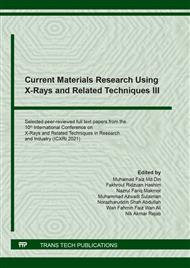p.319
p.326
p.332
p.337
p.343
p.348
p.355
p.361
p.367
Electrical Properties and Raman Scattering of Palm Oil Based Carbon Nanotube
Abstract:
This paper studies the electrical efficiency of carbon nanotubes (CNT) with nanosized diameter inserted into palm-based oil at various concentrations (0, 0.0125, 0.025, 0.0375, 0.05, 0.125, 0.25 and 0.5 g/L). Dispersion methods, including sonication and drying process were systematically applied for producing stable CNT nanofluids. Several parameters such as electrical properties (AC breakdown voltage) and dielectric properties (dissipation factor, relative permittivity and resistivity) were measured accordingly based on IEC 60156 and IEC 60247 international standards. The test results reveal that the higher concentration of CNTs dispersed in palm oil, the lower AC breakdown voltages produced. At 0.5 g/L concentration, the average of 50 breakdown was 22.30 kV, which is 72.33% decrement compared to palm oil without any nanofiller. Besides, the permittivity and resistivity of CNT nanofluids decrease as concentrations increased, while dissipation factor increases along with CNT concentrations. In order to further support this indication, Raman analysis is measured to relate the behavior of AC breakdown voltages and chemical structure of CNT nanofluids. Based on the Raman spectra at 2800-3200 cm-1 region, it is shown that the value of total unsaturated fatty acid and total fatty acid decreased as concentrations of CNT increased. This occurrence directly influences the degradation performance of AC breakdown voltages.
Info:
Periodical:
Pages:
343-347
Citation:
Online since:
January 2022
Keywords:
Price:
Сopyright:
© 2022 Trans Tech Publications Ltd. All Rights Reserved
Share:
Citation:


